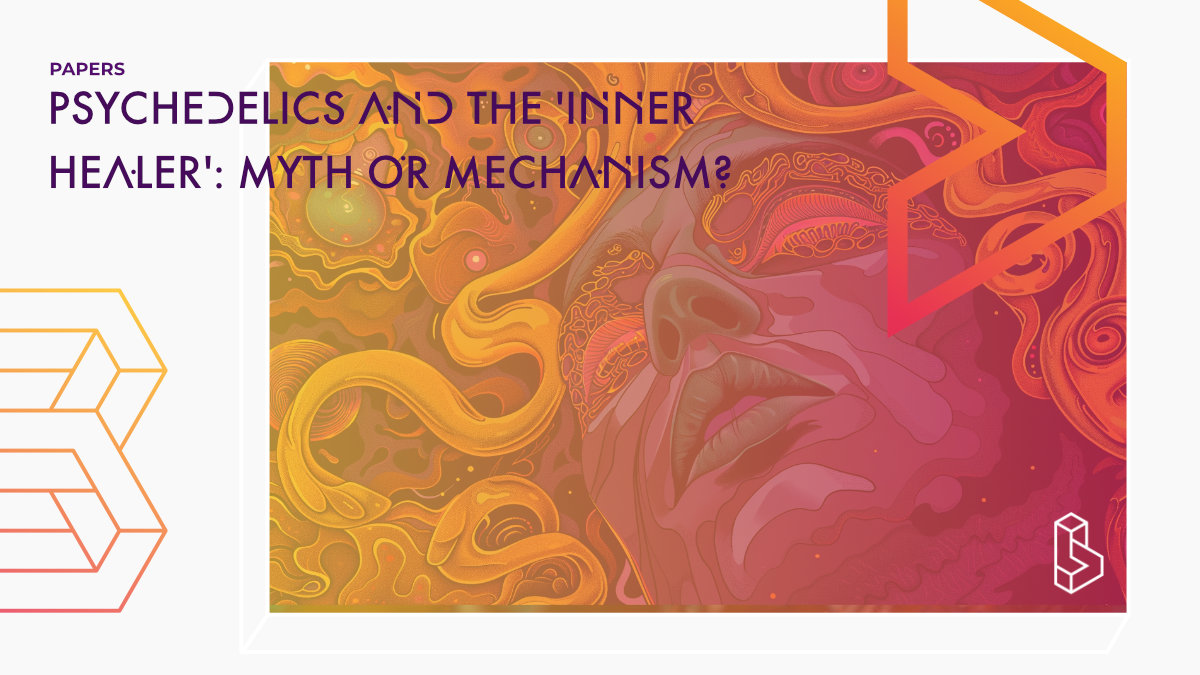This re-analysis of an RCT (n=59) examines the concept of an ‘inner healer’ effect associated with psilocybin. Participants receiving a high dose of psilocybin (25mg, 2x) reported higher inner healer scores compared to those receiving a placebo (1mg). Furthermore, higher inner healer scores in the high-dose group correlated with improved depressive symptoms two weeks post-dosing, suggesting a potential therapeutic mechanism.
Abstract of Psychedelics and the ‘inner healer’: Myth or mechanism?
“Background: Reference to an intrinsic healing mechanism or an ‘inner healer’ is commonplace amongst psychedelic drug-using cultures. The ‘inner healer’ refers to the belief that psychedelic compounds, plants or concoctions have an intrinsically regenerative action on the mind and brain, analogous to intrinsic healing mechanisms within the physical body, for example, after sickness or injury.
Aims: Here, we sought to test and critique this idea by devising a single subjective rating item pertaining to perceived ‘inner healing’ effects.
Methods: The item was issued to 59 patients after a single high (25 mg, n = 30) or ‘placebo’ (1 mg, n = 29) dose of psilocybin in a double-blind randomised controlled trial of psilocybin for depression.
Results: Inner healer scores were higher after the high versus placebo dose of psilocybin (t = 3.88, p < 0.001). Within the high-dose sub-sample only, inner healer scores predicted improved depressive symptomatology at 2 weeks post-dosing.
Conclusions: The principle of activating inner healing mechanisms via psychedelics is scientifically nascent; however, this study takes a positivist and pragmatic step forward, asking whether it warrants further examination.”
Authors: Joseph Peill, Miriam Marguilho, David Erritzoe, Tommaso Barba, Kyle T Greenway, Fernando Rosas, Christopher Timmermann & Robin Carhart-Harris
Summary of Psychedelics and the ‘inner healer’: Myth or mechanism?
Introduction
The principle of intrinsic healing refers to the capacity of living systems to restore or recover after injury or sickness. It is applied to mental health and postulates implicit processes that have an intrinsic directionality or teleology to them.
Analogies are often made between intrinsic psychological and physical healing, as well as self-regulating processes elsewhere in living systems, and ‘inner healing’ is a theme found in many cultures and traditions.
Find this paper
Psychedelics and the 'inner healer': Myth or mechanism?
https://doi.org/10.1177/02698811241239206
Open Access | Google Scholar | Backup | 🕊
Cite this paper (APA)
Peill, J., Marguilho, M., Erritzoe, D., Barba, T., Greenway, K. T., Rosas, F., ... & Carhart-Harris, R. (2024). Psychedelics and the ‘inner healer’: Myth or mechanism?. Journal of Psychopharmacology, 02698811241239206.
Study details
Compounds studied
Psilocybin
Topics studied
Depression
Treatment-Resistant Depression
Study characteristics
Original Re-analysis
Placebo-Controlled
Double-Blind
Randomized
Re-analysis
Participants
59
Humans
Institutes
Institutes associated with this publication
Imperial College LondonThe Centre for Psychedelic Research studies the action (in the brain) and clinical use of psychedelics, with a focus on depression.
Compound Details
The psychedelics given at which dose and how many times
Psilocybin 25 mg | 2xLinked Research Papers
Notable research papers that build on or are influenced by this paper
Trial of Psilocybin versus Escitalopram for DepressionThis double-blind placebo-controlled study (n=59) compared psilocybin (2x25mg; 3 weeks apart) to escitalopram (SSRI) over a six-week period and found large improvements in depression scores for those suffering from depression (MDD) in both groups. On the main measure of depression, the QIDS-SR-16, there was no significant difference between both groups. The study did find significant differences, favoring psilocybin, on the HAM-D-17, MADRS, avoidance, flourishing, wellbeing, and suicidality.
Linked Clinical Trial
Psilocybin vs Escitalopram for Major Depressive Disorder: Comparative MechanismsThis is a randomised double-blind clinical trial. The aim is to compare the efficacy and mechanisms of action of psilocybin, the primary psychoactive substance in 'magic mushrooms', with the SSRI (selective serotonin reuptake inhibitor) escitalopram for major depressive disorder (MDD).

